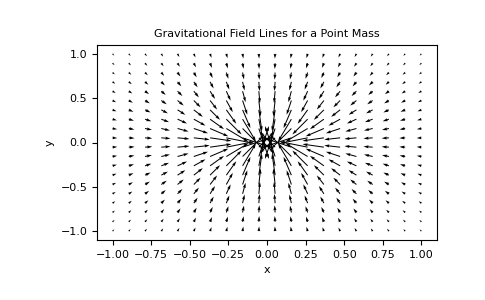geoana.gravity.PointMass.gravitational_field#
- PointMass.gravitational_field(xyz)#
Gravitational field due to a point mass. See Blakely, 1996 equation 3.3.
\[\mathbf{g} = \nabla U(P)\]- Parameters:
- xyz(…, 3) numpy.ndarray
Observation locations in units m.
- Returns:
- (…, 3) numpy.ndarray
Gravitational field at observation locations xyz in units \(\frac{m}{s^2}\).
Examples
Here, we define a point mass with mass=1kg and plot the gravitational field lines in the xy-plane.
>>> import numpy as np >>> import matplotlib.pyplot as plt >>> from geoana.gravity import PointMass
Define the point mass.
>>> location = np.r_[0., 0., 0.] >>> mass = 1.0 >>> simulation = PointMass( >>> mass=mass, location=location >>> )
Now we create a set of gridded locations and compute the gravitational field.
>>> X, Y = np.meshgrid(np.linspace(-1, 1, 20), np.linspace(-1, 1, 20)) >>> Z = np.zeros_like(X) + 0.25 >>> xyz = np.stack((X, Y, Z), axis=-1) >>> g = simulation.gravitational_field(xyz)
Finally, we plot the gravitational field lines.
>>> plt.quiver(X, Y, g[:,:,0], g[:,:,1]) >>> plt.xlabel('x') >>> plt.ylabel('y') >>> plt.title('Gravitational Field Lines for a Point Mass') >>> plt.show()
(
Source code,png,pdf)